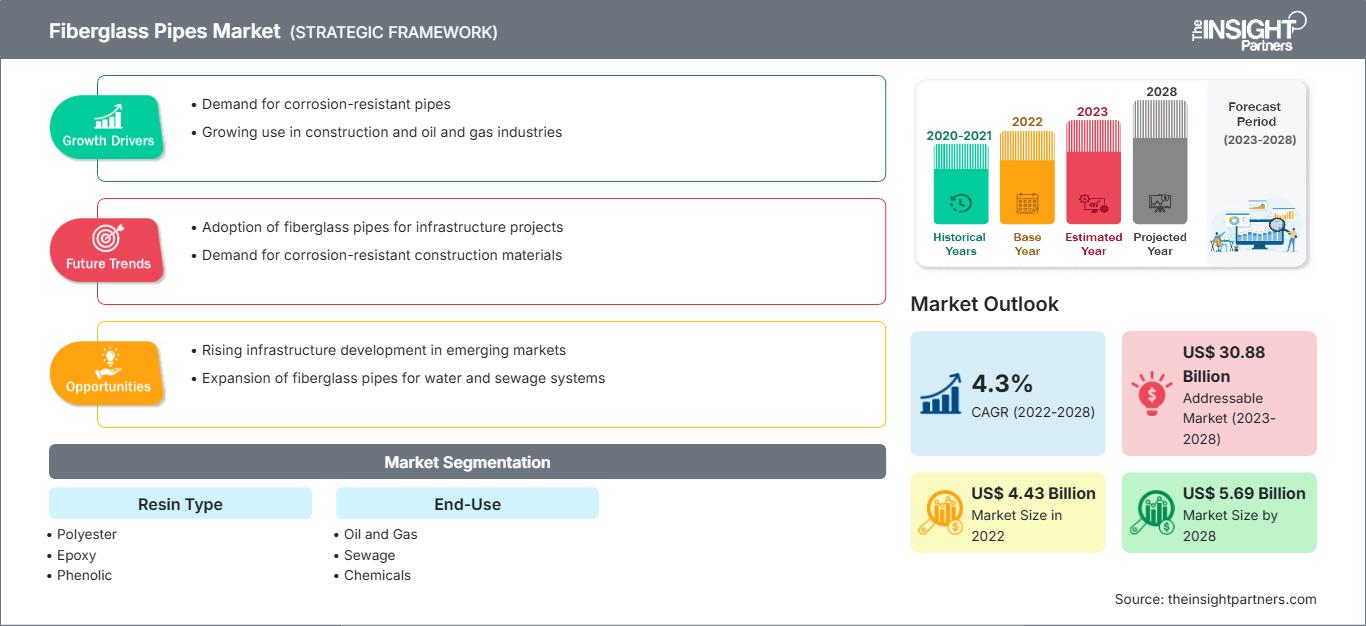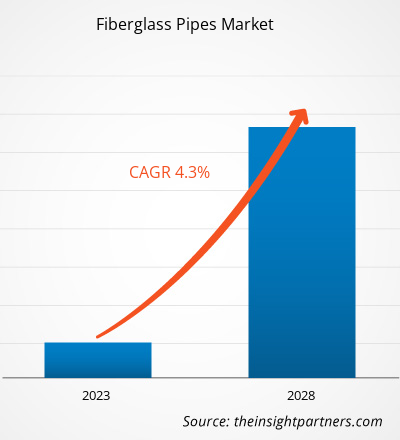[Forschungsbericht] Der Markt für Glasfaserrohre wurde im Jahr 2022 auf 4.431,10 Millionen US-Dollar geschätzt und soll bis 2028 auf 5.692,52 Millionen US-Dollar anwachsen. Es wird erwartet, dass er von 2022 bis 2028 mit einer durchschnittlichen jährlichen Wachstumsrate von 4,3 % wächst.
MARKTANALYSE
Glasfaserrohre werden im Kontaktform- oder Filamentwickelverfahren unter Verwendung von Glasfaserverstärkung und Harzsystemen wie Polyester, Epoxid und Phenolharz hergestellt. Glasfaserrohre werden häufig zum Transport von Erdölprodukten und Erdgas verwendet. Glasfaserrohre sind Verbundrohre mit ausgezeichneter Beständigkeit gegen korrosive Umgebungen, einschließlich Böden, Kohlenwasserstoffen, Salzwasser, H2S und chemischen Verbindungen, die in jedem Ölfeld vorkommen können. Glasfaserrohre sind extrem langlebig, haben einen geringen Reibungskoeffizienten und unterliegen weniger Verschleiß, weshalb sie in der Öl- und Gasindustrie sehr beliebt sind. Glasfaserrohre sind eine ausgezeichnete und kostengünstige Wahl für Wasserversorgungs- und Abwasseranwendungen, mit langfristiger Wartung und niedrigen Pumpenbetriebskosten aufgrund korrosionsbedingter Reibungsverluste.
WACHSTUMSTREIBER UND HERAUSFORDERUNGEN
Die zunehmende Installation von Öl- und Gaspipelines weltweit hat das Marktwachstum von Glasfaserrohren gefördert. Glasfaserrohre gelten als zuverlässige und kostengünstige Alternative zu Stahlrohren für den Korrosionsschutz an Land und auf See im Nieder- bis Hochdruck-Öl- und Gassektor. Die Öl- und Gasindustrie meldet einen steigenden Kraftstoffbedarf aufgrund des schnellen Wirtschaftswachstums und der steigenden Ölnutzung für Anwendungen wie Rohstoffe und Stromerzeugung. Im Jahr 2021 gehörte Russland zu den fünf größten Energieproduzenten und -verbrauchern der Welt und produzierte 595,2 Millionen Tonnen Rohöl, von denen 286,6 Millionen Tonnen exportiert wurden. Dies geht aus dem 2023 von Bruegel AISBL veröffentlichten Bericht hervor. Der Bericht enthüllte auch, dass Rohöl hauptsächlich über zwei Routen exportiert wird: per Pipeline und per Öltanker auf See. Laut dem 2023 vom Center for Eastern Studies veröffentlichten Bericht plante die russische Regierung, die Gasexporte nach China zu steigern und bis 2030 jährlich 98 Milliarden Kubikmeter Gas zu liefern. Dies soll teilweise durch die geplante Pipeline Power of Siberia-2 erreicht werden. Darüber hinaus ist die steigende Nachfrage nach Glasfaserrohren aus der chemischen Industrie ein weiterer Faktor, der das Wachstum von Glasfaserrohren unterstützt. Die Schwankungen der Rohstoffpreise stellen eine Herausforderung für den Markt für Glasfaserrohre dar. Glasfaser wird aufgrund seiner hohen Festigkeit, seines geringen Gewichts und seiner Designflexibilität in zahlreichen Branchen wie Energie, Elektronik, Automobil, Transport, Baumaterialien und Infrastrukturbaumaterialien umfassend eingesetzt. Die Kosten für Rohstoffe, Kraftstoff und Arbeitskräfte stiegen im Jahr 2021 deutlich an, was die Produktionskosten für Glasfaser erhöhte.
Passen Sie diesen Bericht Ihren Anforderungen an
Sie erhalten kostenlos Anpassungen an jedem Bericht, einschließlich Teilen dieses Berichts oder einer Analyse auf Länderebene, eines Excel-Datenpakets sowie tolle Angebote und Rabatte für Start-ups und Universitäten.
Markt für Glasfaserrohre: Strategische Einblicke

-
Holen Sie sich die wichtigsten Markttrends aus diesem Bericht.Dieses KOSTENLOSE Beispiel umfasst Datenanalysen, die von Markttrends bis hin zu Schätzungen und Prognosen reichen.
SEGMENTIERUNG UND UMFANG DES BERICHTS
Die „Globale Marktanalyse für Glasfaserrohre bis 2030“ ist eine spezialisierte und detaillierte Studie mit Schwerpunkt auf globalen Markttrends und Wachstumschancen. Der Bericht bietet einen Überblick über den globalen Markt mit detaillierter Marktsegmentierung nach Harztyp, Endverwendung und Geografie. Der globale Markt für Glasfaserrohre verzeichnete in der jüngeren Vergangenheit ein starkes Wachstum und dürfte diesen Trend im Prognosezeitraum fortsetzen. Der Bericht liefert wichtige Statistiken zum weltweiten Verbrauch von Glasfaserrohren sowie zur Nachfrage in wichtigen Regionen und Ländern. Darüber hinaus bietet der Bericht eine qualitative Bewertung verschiedener Faktoren, die die Marktleistung für Glasfaserrohre in wichtigen Regionen und Ländern beeinflussen. Der Bericht enthält auch eine umfassende Analyse der führenden Akteure auf dem Markt für Glasfaserrohre und ihrer wichtigsten strategischen Entwicklungen. Es sind auch mehrere Analysen der Marktdynamik enthalten, um die wichtigsten Antriebsfaktoren, Markttrends und lukrativen Gelegenheiten zu identifizieren, die wiederum bei der Identifizierung der wichtigsten Einnahmequellen helfen.
Darüber hinaus bieten die Ökosystemanalyse und die Fünf-Kräfte-Analyse von Porter eine 360-Grad-Ansicht des globalen Marktes für Glasfaserrohre, die zum Verständnis der gesamten Lieferkette und der verschiedenen Faktoren beiträgt, die das Marktwachstum beeinflussen.
SEGMENTANALYSE
Der globale Markt für Glasfaserrohre ist nach Harztyp und Endverwendung segmentiert. Basierend auf dem Harztyp wird der Markt für Glasfaserrohre in Polyester, Epoxid, Phenol und andere segmentiert. Auf der Grundlage der Endverwendung wird der Markt in Öl und Gas, Abwasser, Chemikalien, Landwirtschaft und andere unterteilt. Basierend auf dem Harztyp machte das Polyestersegment einen erheblichen Anteil aus. Polyesterharz ist ein einfach zu verwendendes und wirtschaftliches Polymer und ein wichtiger Bestandteil vieler Branchen. Es ist das am häufigsten verwendete Pultrusionsharz in der Verbundwerkstoffherstellung, da es hinsichtlich der Konstruktion von Polymerketten sehr anpassungsfähig ist. Epoxidharze werden von Herstellern zur Produktion von glasfaserverstärkten Epoxidrohren (GRE) verwendet, die in der Schifffahrt und Offshore-Industrie sowie in der Öl- und Gasindustrie und der Petrochemie eingesetzt werden. Phenolharz wird aufgrund seiner hohen Beständigkeit zur Herstellung von Glasfaserrohren für die Öl- und Gasindustrie verwendet. Das sonstige Segment der Harzarten umfasst Vinylesterharze und Polyurethanharze. Gemessen am Endverbrauch hatte der Öl- und Gassektor aufgrund des stetigen Anstiegs bei der Exploration und Produktion von Öl und Gas den größten Anteil. Glasfaserrohre werden aufgrund ihres besseren Festigkeits-Gewichts-Verhältnisses und ihrer Korrosionsbeständigkeit besonders für die Abwasserbehandlung empfohlen. Glasfaserrohre werden in Chemieanlagen zum Transport von chemischen Flüssigkeiten und Industriegasen verwendet.
REGIONALE ANALYSE
Der Bericht bietet einen detaillierten Überblick über den globalen Markt für Glasfaserrohre in Bezug auf fünf Hauptregionen, nämlich: Nordamerika, Europa, Asien-Pazifik (APAC), Naher Osten und Afrika (MEA) sowie Süd- und Mittelamerika. Der asiatisch-pazifische Raum hatte einen erheblichen Anteil am Markt und wurde im Jahr 2022 auf über 1 Milliarde US-Dollar geschätzt. Im Jahr 2028 werden voraussichtlich rund 2 Milliarden US-Dollar erreicht. Der asiatisch-pazifische Raum ist aufgrund des Wachstums der Chemie- und Öl- und Gasbranche sowie der zunehmenden Urbanisierung, die zu einer erhöhten Nachfrage nach Abwassersystemen führt, ein bedeutender Markt für Glasfaserrohre. Laut dem International Council of Chemical Associations (ICCA) trägt die Chemieindustrie im asiatisch-pazifischen Raum am meisten zum BIP und zur Beschäftigung der Region bei und generiert 45 % des gesamten jährlichen Wirtschaftswerts der Branche und 69 % aller unterstützten Arbeitsplätze. Der Anstieg der ausländischen Direktinvestitionen führt ebenfalls zu regionalem Wirtschaftswachstum und stärkt die Industrialisierung in der Region weiter. Auch in Europa wird ein beträchtliches Wachstum im Wert von etwa 950,00 Millionen US-Dollar im Jahr 2022 erwartet, was auf die zunehmende Verwendung von Glasfaserrohren in verschiedenen Branchen zurückzuführen ist, darunter Öl und Gas, Chemie sowie Wasser- und Abwasseraufbereitung.
BRANCHENENTWICKLUNGEN UND ZUKÜNFTIGE CHANCEN
Der Bericht bietet einen detaillierten Überblick über den globalen Markt für Glasfaserrohre in Bezug auf fünf Hauptregionen, nämlich Nordamerika, Europa, Asien-Pazifik (APAC), Naher Osten und Afrika (MEA) und Süd- und Südamerika. Mittelamerika.
Im März 2023 erhielt Future Pipe Industries (Ägypten) vom strategischen Geschäftspartner des Unternehmens, Petrobel Petroleum Co, eine Anerkennungsurkunde für die Installation einer GRE-Rohöl-Übergangsleitung von Tanks nach Petrico (Ägypten).
Im Februar 2022 erweiterte Future Pipe Industries seine Produktionsstätte in Saudi-Arabien um zwei neue Produktionslinien für FlexstrongTM, ein aufspulbares Hochdruckrohr mit einem Durchmesser von bis zu 6 Zoll.
AUSWIRKUNGEN VON COVID/AUSWIRKUNGEN DES GEOPOLITISCHEN SZENARIOS/AUSWIRKUNGEN DER REZESSION
Der Bericht bietet einen detaillierten Überblick über den globalen Markt für Glasfaserrohre in Bezug auf fünf Hauptregionen, nämlich Nordamerika, Europa, Asien-Pazifik (APAC), Naher Osten und Afrika (MEA) sowie Süd- und Mittelamerika. Die COVID-19-Pandemie wirkte sich negativ auf die Weltwirtschaft aus und bremste das Wachstum verschiedener Branchen wie Öl & Gas, Chemie & Werkstoffe sowie Landwirtschaft. Die Schließung zahlreicher Produktionsstätten und Fabriken in Nordamerika, Europa, im asiatisch-pazifischen Raum, Südamerika sowie im Nahen Osten und Afrika unterbrach die globale Lieferkette. Viele Unternehmen kündigten mögliche Verzögerungen bei Produktlieferungen an und prognostizierten einen Einbruch ihrer Produktverkäufe. Darüber hinaus erschwerten Reisebeschränkungen in Ländern Europas, des asiatisch-pazifischen Raums und Nordamerikas die Geschäftskooperation und Partnerschaftsmöglichkeiten. All diese Faktoren behinderten den Fortschritt der Chemie- und Werkstoffindustrie und bremsten das Wachstum verschiedener damit verbundener Märkte. Im Jahr 2021 erlangten Unternehmen ihre Produktionskapazitäten zurück, da die Regierungen verschiedener Länder die zuvor verhängten Beschränkungen lockerten. Darüber hinaus entspannte eine verstärkte COVID-19-Impfkampagne die Situation und führte zu einem Anstieg der Geschäftsaktivitäten weltweit. Die Inbetriebnahme der Produktionsstätten wirkte sich positiv auf den Markt für Glasfaserrohre aus. Darüber hinaus konnten die Hersteller die Lücke zwischen Angebot und Nachfrage schließen, indem sie ihre Kapazitäten voll ausschöpften. Darüber hinaus wird erwartet, dass die Export- und Importvolumina in der Chemie- und Werkstoffindustrie in den kommenden Jahren aufgrund der Lockerung der Grenz- und Handelsbeschränkungen deutlich steigen werden.
Glasfaserrohre
Regionale Einblicke in den Markt für GlasfaserrohreDie Analysten von The Insight Partners haben die regionalen Trends und Faktoren, die den Markt für Glasfaserrohre im Prognosezeitraum beeinflussen, ausführlich erläutert. In diesem Abschnitt werden auch die Marktsegmente und die geografische Lage von Glasfaserrohren in Nordamerika, Europa, im asiatisch-pazifischen Raum, im Nahen Osten und Afrika sowie in Süd- und Mittelamerika erörtert.
Umfang des Marktberichts zu Glasfaserrohren
| Berichtsattribut | Einzelheiten |
|---|---|
| Marktgröße in 2022 | US$ 4.43 Billion |
| Marktgröße nach 2028 | US$ 5.69 Billion |
| Globale CAGR (2022 - 2028) | 4.3% |
| Historische Daten | 2020-2021 |
| Prognosezeitraum | 2023-2028 |
| Abgedeckte Segmente |
By Harztyp
|
| Abgedeckte Regionen und Länder |
Nordamerika
|
| Marktführer und wichtige Unternehmensprofile |
|
Marktdichte von Glasfaserrohren: Auswirkungen auf die Geschäftsdynamik verstehen
Der Markt für Glasfaserrohre wächst rasant. Die steigende Nachfrage der Endverbraucher ist auf Faktoren wie veränderte Verbraucherpräferenzen, technologische Fortschritte und ein stärkeres Bewusstsein für die Produktvorteile zurückzuführen. Mit der steigenden Nachfrage erweitern Unternehmen ihr Angebot, entwickeln Innovationen, um den Bedürfnissen der Verbraucher gerecht zu werden, und nutzen neue Trends, was das Marktwachstum weiter ankurbelt.

- Holen Sie sich die Markt für Glasfaserrohre Übersicht der wichtigsten Akteure
WETTBEWERBSLANDSCHAFT UND WICHTIGE UNTERNEHMEN
Zu den wichtigsten Akteuren auf dem Markt für Glasfaserrohre gehören unter anderem Amiblu Holding GmbH, Chemical Process Piping Pvt Ltd, EPP Composites Pvt Ltd, Fibrex LLC, Future Pipe Industries LLC, Gruppo Sarplast Srl, Kuzeyboru AS, Lianyungang Zhongfu Lianzhong Composites Group Co Ltd, NOV Inc, Saudi Arabian Amiantit Co, Sunrise Industries (India) Ltd, Poly Plast Chemi Plants (I) Pvt Ltd, Plasticon Germany GmbH und Kurotec-KTS GmbH.
- Historische Analyse (2 Jahre), Basisjahr, Prognose (7 Jahre) mit CAGR
- PEST- und SWOT-Analyse
- Marktgröße Wert/Volumen – Global, Regional, Land
- Branchen- und Wettbewerbslandschaft
- Excel-Datensatz
Aktuelle Berichte
Verwandte Berichte
Erfahrungsberichte
Grund zum Kauf
- Fundierte Entscheidungsfindung
- Marktdynamik verstehen
- Wettbewerbsanalyse
- Kundeneinblicke
- Marktprognosen
- Risikominimierung
- Strategische Planung
- Investitionsbegründung
- Identifizierung neuer Märkte
- Verbesserung von Marketingstrategien
- Steigerung der Betriebseffizienz
- Anpassung an regulatorische Trends






















 Kostenlose Probe anfordern für - Markt für Glasfaserrohre
Kostenlose Probe anfordern für - Markt für Glasfaserrohre